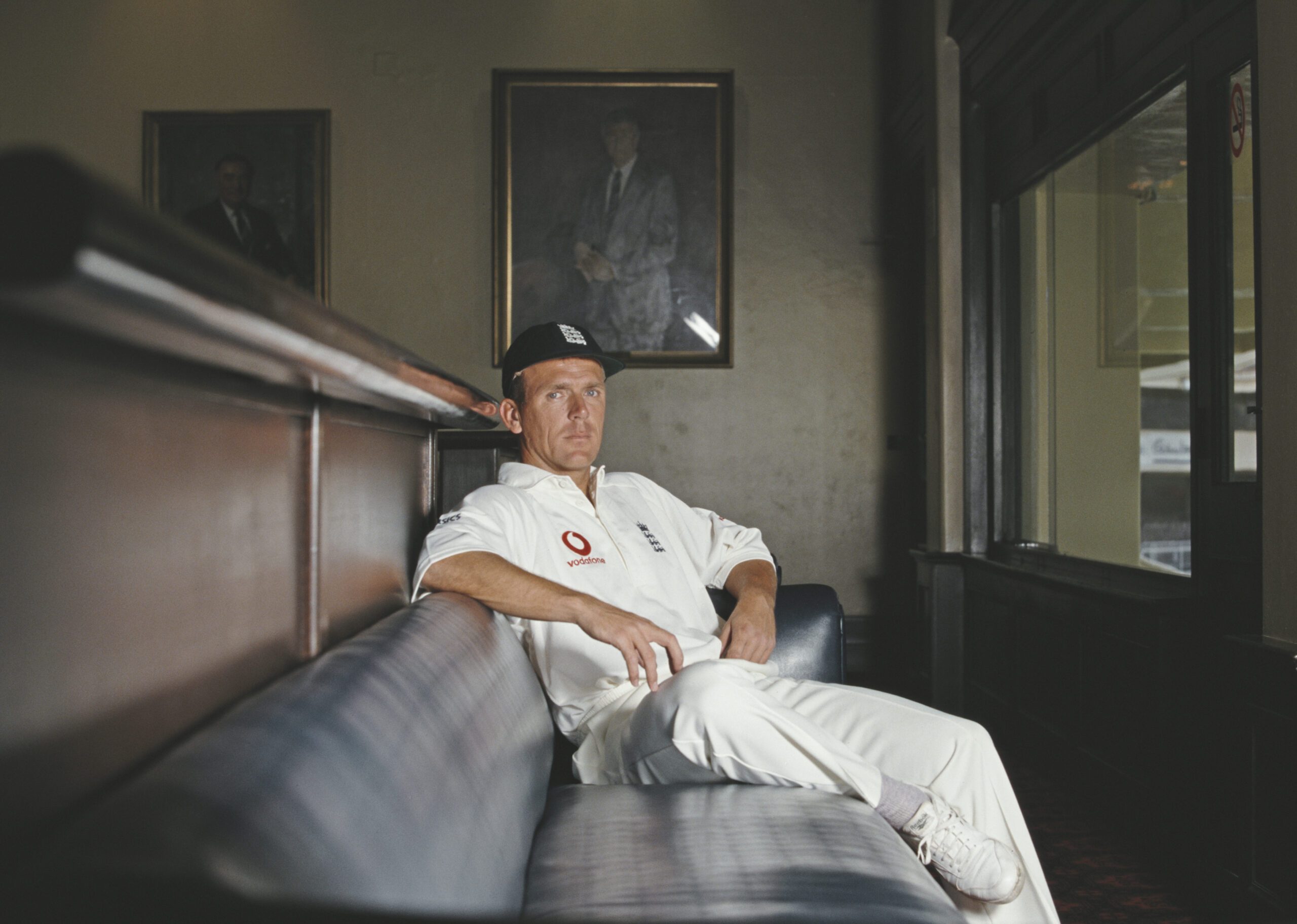Ben Stokes celebrated his 100th Test cap during the India series and Jonny Bairstow will do so in the final match. Richard Spiller looks at who Surrey’s most capped English Test players are.
Alec Stewart – 133
The sixth Englishman and first Surrey player to reach three-figures, Alec Stewart’s 133 was a record for England until being overtaken by Jimmy Anderson, Stuart Broad, Alastair Cook and Joe Root. That was some achievement given his debut came when he was approaching 27.
Stewart’s versatility meant that he played 82 matches as a wicketkeeper-bat and 51 in his favourite role of top-order specialist. It was in that latter role that he scored two centuries against West Indies in Barbados in 1994, two of 15 tons for his country. The faster they came, the happier he was – not a surprise for a player who spent so many winters playing on pacy pitches in Perth.
Stewart scored 8,463 Test runs at 39 before retiring in 2003, also appearing in 170 ODIs, captaining in 1998-99, and now as Surrey’s director of cricket takes pride in producing players for international cricket alongside winning trophies for Surrey.
Kevin Pietersen – 104
Established as one of the world’s leading players by the time he joined Surrey in 2011 – following spells at Nottinghamshire and Hampshire – Kevin Pietersen’s appearances were sporadic for his third county. He scored 533 runs at 106 as England whitewashed India that summer but a stormy relationship with England coaches and captains was beginning to take effect.
After the 2013-14 Ashes tour, Pietersen was omitted, never to return. His raw figures, 8,181 runs at 47, clearly place him among the top bracket – and it’s unlikely that anyone who witnessed the coruscating 158 at The Oval which sealed England’s 2005 Ashes victory will ever forget it.
Graham Thorpe – 100
England were often up against it for much of Graham Thorpe’s dozen years in international cricket – but never beaten until he was dismissed. The compact Farnham-bred left-hander could play both cavalier and roundhead, tailoring an innings to the circumstances, which were often difficult.
Thorpe scored a century in his maiden Test, against Australia at Trent Bridge, overcoming an all-conquering attack including Glenn McGrath and Shane Warne, the first Englishman to do so for 20 years, following an apprenticeship stretching to four A tours. He was equally at home against pace and spin and backed it up by being a reliable catcher.
His 6,744 Test runs came at 44 apiece and included 16 centuries, none more stirring than the 124 he made against South Africa at The Oval in 2003 after a year out of the side. That extended a career which also included 82 ODIs, playing his 100th Test against Bangladesh in 2005. By then a persistent back injury increasingly hampered him, forcing him into retirement at the end of that season, becoming an accomplished coach.
Bob Willis – 90
Born in Sunderland, Bob Willis grew up in Surrey and played his early cricket in the county.
Having made a strong impression in early matches for Surrey in 1969-70, he was called into England’s Ashes tour in 1970-71 as a replacement for Alan Ward at the recommendation of John Edrich. Although raw, Willis took 16 wickets in four matches, taking 12 wickets to offer vital support to spearhead John Snow as the urn was recovered.
Back home, he had to fight for a place with Robin Jackman as Surrey won the County Championship under Micky Stewart and that – plus a dispute over pay – persuaded him that he should move to Warwickshire.
Willis went on to become one of England’s finest modern-day fast bowlers, despite persistent knee problems. His 8-43 to produce a miracle victory at Headingley in 1981 was a highlight of his successful career. Over 90 Tests he claimed 325 wickets, captaining his country for two years, before going on to become a popular pundit on Sky Sports.
Ken Barrington – 82
Amid the strokeplay of Dexter, Cowdrey and Graveney, Ken Barrington’s more prosaic style was England’s bedrock through the 1960s. He had the shots to match them all but, having lost his Test place in 1955, vowed when he won it back four years later that it would be for keeps.
Barrington became the man England could depend upon in all circumstances and conditions, only occasionally offering a glimpse of the cavalier. It earned him 6,806 runs at 58.67, a record few can match, but neither selectors nor spectators always appreciated it, and he was once dropped for slow scoring.
After a first heart attack ended his career at the age of 37, he became a pundit, selector and coach before a second heart attack proved fatal on England’s tour of West Indies in 1981. His contribution to Surrey and England cricket is commemorated by the Ken Barrington Centre at the Kia Oval.
John Edrich – 77
While the glamour boys gained all the glory, it would be John Edrich who toughed it out against the quicks. His time in Test cricket – 1963-76 – came when there were plenty of fast bowlers but still little decent protective equipment, Edrich being knocked out cold by South African Peter Pollock in 1965 and having ribs broken by Australian Dennis Lillee in 1974-75.
He relied on a conservative range of strokes and a simple view of the game, reckoning he would be okay until bowlers could deliver more than one ball at a time. It served him well, making 5,138 Test runs at 43 amid the 39,790 grossed at first-class level. Edrich also captained England in one Test, deputising for Mike Denness in Sydney in 1974-75 when those broken ribs added to the pain of Australia regaining the Ashes.
Mark Butcher – 71
From a family which boasts five first-class players, Mark Butcher soon settled into Test cricket, making centuries against strong South African and Australian attacks in 1998. The opener was even drafted in as emergency captain for a Test against New Zealand the following year but was dropped for the following match as his form slumped.
When Butcher regained his place in 2001, he capped it by playing the innings of his life – perhaps anyone’s life – by despatching the all-conquering Australians around Headingley for 173no to earn England an unlikely victory. Butcher remained a fixture in the top order until a hand injury on the South Africa tour of 2004-05.
Any lingering hopes of a return to international level – to build on the 4,288 runs at 34 – were terminated by a career-ending knee injury in 2009 which deprived Surrey of an excellent captain and fine player. He was not lost to the sport, though, and has become an accomplished commentator covering the global game.
Peter May – 66
Few young players have lived up to their rich promise so thoroughly as Peter May. Only two years of national service delayed his Test debut until he was 21 – scoring 138 against South Africa at Headingley – and there would be few missteps to establishing himself in the top bracket.
May was the outstanding batter in Surrey’s run of seven Championship titles from 1952-58, when international calls permitted, becoming England captain in 1955, two years before he succeeded Stuart Surridge as Surrey skipper. May would go on to set a record in captaining England for 41 Tests – winning 20 of them – but the latter stages of both his tenure and career were dogged by ill-health.
May played his final Test aged just 31 and bowed out of first-class cricket a year later to the enormous regret of those who remembered his peerless on-drive and command of the crease. A haul of 4,537 runs at 46 underlines why.
Jack Hobbs – 61
The most prolific run-scorer in cricket history, Jack Hobbs’s Test career was spread over 22 years and heaven knows how many more runs he might have scored but for losing four years to the First World War.
Dubbed “The Master”, he made 61,237 first-class runs and of his 199 centuries, half were scored after he passed the age of 40. Test cricket brought the best out of Hobbs, given he averaged 56 – up from 50 overall – and his supreme footwork ensured he had an answer to the best bowlers.
Modesty and generosity, which even stretched to giving his wicket away to bowlers who he felt deserved it once he had made a big score, were hallmarks of a man whose achievements were celebrated by the Hobbs Gates, which mark the main entrance to The Kia Oval.
Mark Ramprakash – 52
The bulk of Mark Ramprakash’s Test career had been played when he was at Middlesex but a typically prolific start to the 2001 season, his first at Surrey, earned a recall.
Ramprakash capped that by making a fighting 133 at The Oval, his second and final Test century, but he lost his place after the following winter’s tours of India and New Zealand.
If a Test average of 27 marked him down as an underachiever, against Australia – the best side in the world at time – it rose to 42. And it meant Surrey would benefit from the rich autumn of his career, at its peak when he scored 2,000 first-class runs in both the 2006 and 2007 campaigns. He became the 25th – and probably final – player to pass 100 first-class centuries, finishing with 114.
Sir Alec Bedser – 51
It’s just as well Alec Bedser was constructed in such sturdy fashion, given he had to carry the England attack for nigh on a decade after the Second World War. The war meant both Alec and twin Eric’s nascent careers – after just two years on the staff – were put on hold for another seven seasons.
But when cricket restarted in 1946, Bedser was picked immediately by England, who were impressed by his relentless accuracy at medium-pace. His stock ball, swung into right-handers, was later joined by a ripping leg-cutter. His first two Tests brought 11 wickets each and he was established as a starter, the peak coming when he claimed 39 wickets in five matches as England regained the Ashes in 1953, among a total of 236.
After his playing days were over, he was an England selector for 23 years, chairing the panel from 1969-81, and was knighted in 1996.
Tony Lock – 49
Just 17 when he made his first appearance for Surrey in 1946, Tony Lock’s England debut came four years later. He would form a formidable double act, for both county and country, with Jim Laker, not least in regaining the Ashes in 1953.
Lock’s aggressive left-arm spin was matched by his prehensile catching close to the wicket. Most effective in English conditions, there was controversy over Lock’s action on several occasions, but he successfully remodelled it in the latter stages of his career.
After leaving Surrey in 1963, Lock enjoyed fruitful spells captaining Western Australia and Leicestershire, making an unlikely England comeback for two Tests in the Caribbean in 1968. He claimed 174 Test wickets at 25.
Jim Laker – 46
Has the world seen a better off-spinner? England’s selectors took a long time to make up their minds, partly because Bradman’s Australians gave Jim Laker a mauling early in his Test career.
Surrey’s seven successive County Championship titles from 1952-58 owed much to Laker and Lock’s spin partnership, destroying teams around the country and not just at The Oval, where they were lethal. It was there that they ran through the Australians to regain the Ashes in 1953 and Laker would have his ultimate revenge on them at Old Trafford three years later by taking 19-90, the best-ever figures in Test history.
A son of Yorkshire, Laker spun the ball viciously – no wonder he suffered from an arthritic finger – which was allied to superb control. His 193 wickets cost just 21 apiece and later he would become an accomplished television commentator for BBC, forming a fine partnership with Richie Benaud, and chaired Surrey’s cricket committee.
Ollie Pope – 42 not out
Had it not been for dreadful luck with three shoulder dislocations, Ollie Pope would surely have been well past his half-century of Test appearances by now.
If being picked to play against India in 2018 as a 20-year-old with just 15 first-class appearances was asking much, Pope has become effectively an automatic choice – when fit – to the extent that he is now vice-captain to Ben Stokes. Those injury-enforced absences interrupted his international development and there have been fallow periods but he has always fought back.
Pope grew up keeping wicket and has performed capably for both England and Surrey – when Ben Foakes has been unavailable – while proving a fine operator at short-leg.
Tom Hayward – 35
Success against the best team in the world – usually Australia – has always been regarded as a mark of class. Given Tom Hayward’s 35 appearances included 20 Tests against Australia, it was just as well, scoring 1,999 runs at 34 at a time when pitches offered many challenges.
Although he was born and died in Cambridge, Hayward’s extensive cricket-playing family had firm roots in Mitcham. The second man after WG Grace to reach 100 first-class centuries, Hayward reached 104 but was 43 when the First World War broke out and did not return when cricket resumed. As an early mentor to Jack Hobbs, his opening partner, he did Surrey and England yet more service.








